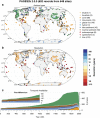A global multiproxy database for temperature reconstructions of the Common Era
- PMID: 28696409
- PMCID: PMC5505119
- DOI: 10.1038/sdata.2017.88
A global multiproxy database for temperature reconstructions of the Common Era
Abstract
Reproducible climate reconstructions of the Common Era (1 CE to present) are key to placing industrial-era warming into the context of natural climatic variability. Here we present a community-sourced database of temperature-sensitive proxy records from the PAGES2k initiative. The database gathers 692 records from 648 locations, including all continental regions and major ocean basins. The records are from trees, ice, sediment, corals, speleothems, documentary evidence, and other archives. They range in length from 50 to 2000 years, with a median of 547 years, while temporal resolution ranges from biweekly to centennial. Nearly half of the proxy time series are significantly correlated with HadCRUT4.2 surface temperature over the period 1850-2014. Global temperature composites show a remarkable degree of coherence between high- and low-resolution archives, with broadly similar patterns across archive types, terrestrial versus marine locations, and screening criteria. The database is suited to investigations of global and regional temperature variability over the Common Era, and is shared in the Linked Paleo Data (LiPD) format, including serializations in Matlab, R and Python.
Conflict of interest statement
The authors declare no competing financial interests.
Figures








Dataset use reported in
- doi: 10.1038/ngeo2510
- doi: 10.1002/2014PA002717
References
Data Citations
-
- PAGES 2k Consortium 2017. figshare. https://doi.org/10.6084/m9.figshare.c.3285353 - DOI
-
- Tierney J. 2010. World Data Center for Paleoclimatology. https://www.ncdc.noaa.gov/paleo/study/10428
-
- Powers L. 2012. World Data Center for Paleoclimatology. https://www.ncdc.noaa.gov/paleo/study/13216
-
- Sundqvist H. 2013. World Data Center for Paleoclimatology. https://www.ncdc.noaa.gov/paleo/study/14349
-
- Stenni B. 2002. World Data Center for Paleoclimatology. https://www.ncdc.noaa.gov/paleo/study/2465
References
-
- Jacoby G. C. Jr & D’Arrigo R. Reconstructed Northern Hemisphere annual temperature since 1671 based on high-latitude tree-ring data from North America. Climatic Change 14, 39–59 (1989).
-
- D’Arrigo R. D. & Jacoby G. C. Secular trends in high northern latitude temperature reconstructions based on tree rings. Climatic Change 25, 163–177 (1993).
-
- D’Arrigo R., Jacoby G., Free M. & Robock A. Northern Hemisphere temperature variability for the past three centuries: tree-ring and model estimates. Climatic Change 42, 663–675 (1999).
-
- Mann M. E., Bradley R. S. & Hughes M. K. Global-scale temperature patterns and climate forcing over the past six centuries. Nature 392, 779–787 (1998).
-
- Mann M. E., Bradley R. S. & Hughes M. K. Northern Hemisphere temperatures during the past millennium: Inferences, uncertainties, and limitations. Geophysical Research Letters 26, 759–762 (1999).
Publication types
Associated data
LinkOut - more resources
Full Text Sources
Other Literature Sources

